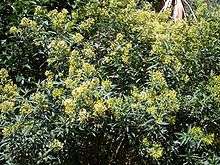Cestrum parqui
| Cestrum parqui | |
|---|---|
 | |
| Scientific classification | |
| Kingdom: | Plantae |
| (unranked): | Angiosperms |
| (unranked): | Eudicots |
| (unranked): | Asterids |
| Order: | Solanales |
| Family: | Solanaceae |
| Genus: | Cestrum |
| Species: | C. parqui |
| Binomial name | |
| Cestrum parqui | |

Cestrum parqui, commonly known as green cestrum or willow-leaved jessamine[1] - and sometimes incorrectly referred to as "mortal nightshade" - is a species of flowering plant native to Chile.
It is a fast, straggly, woody deciduous or semi-evergreen shrub with one or more fragile green stems. The alternate, light green leaves produce a rubber smell when crushed. It produces terminal sprays of small, fragrant, tubular yellow-green flowers 2.5 cm long from late spring to autumn, followed by bunches of small, black, egg-shaped berries summer through fall. All parts of the plant are highly toxic.
Cestrum green is highly attractive to birds, which play a major role in dispersal; seedlings are often found growing under perching trees, along fencelines, and in creek banks, where it is also dispersed by water. Outside of its native range, it is a noxious invasive weed with a deep and persistent root system. It is a significant hazard to livestock (especially cattle) which may eat green cestrum inadvertently or during shortages of other foods, often resulting in death.
In cultivation in the UK this plant has gained the Royal Horticultural Society’s Award of Garden Merit.[1] (confirmed 2017).[2]
See also
References
- 1 2 "RHS Plantfinder - Cestrum parqui". Retrieved 12 January 2018.
- ↑ "AGM Plants - Ornamental" (PDF). Royal Horticultural Society. July 2017. p. 16. Retrieved 24 January 2018.